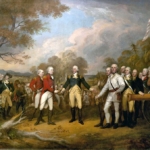Up and Down the Kennebec Valley: Revolution affects Fairfield – Continued
 by Mary Grow
by Mary Grow
(See part 1 of this series here.)
This article will continue the story of Fairfield men who fought in the Revolutionary War, beginning – after a digression – with one important man mentioned last week, William Kendall.
* * * * * *
Photos of the memorial in Fairfield’s Emery Hill Cemetery that the Silence Howard Hayden Chapter, Daughters of the American Revolution, put up in 1911, show General William Kendall’s as the second name. After him come Daniel Page (miscarved as Daniel Pace), David Emery and George Parkhurst, all profiled in last week’s article.
Above these names, in a different script, is the name George Hobbs. A copy of the 1878 map of Shawmut shows a house owned by R. T. Hobbs; otherwise, neither George nor any other Hobbs is mentioned in the Fairfield history.
Fairfield Historical Society member Barbara Gunvaldsen has George Hobbs’ name, and the names of his commanding officers, on her list of Fairfield men who served in the Revolution. FamilySearch’s biography does not identify him as a Revolutionary War veteran.
FamilySearch says George Hobbs was born April 7, 1764, in Berwick, and died Sept. 1, 1853, in Fairfield. (Other men who fought in the Revolution were born as late as 1764.) Your writer found no other record on line, and nothing about R. T. Hobbs.
Compared to Hobbs, William Kendall is famous, although details of his military service are available only in specialized war-related records.
Kendall was born in Georgetown, Maine, on Sept. 1, 1759, according to Major General Carleton Edward Fisher’s 1970 Clinton history; Fisher claimed him as an early – before 1777 – Clinton settler. Find a Grave says he was born Nov. 19, 1759, son of Uzziah and Elizabeth (Pierce) Kendall.
The 1988 Fairfield history says he enlisted in Winslow (Gunvaldsen says in Clinton, as does Fisher, quoting his widow’s claim for a state bounty) in March 1777, as a private, and was “honorably discharged in 1780.” (Your writer surmises that his military titles came from later service in the state militia.)
Kendall promptly came to Fairfield. The town history says in 1780, he “took over” unfinished saw and grist mills atop a two-year-old dam Jonas Dutton built between the west shore of the Kennebec and the closest island, now named Mill Island.
These mills remained in the Kendall family until 1835, the history says, run by Kendall, a brother and an unspecified number of sons. Other men started mills, “but during this era the Kendall Mills were dominant.”
Kendall also bought most of the land that is now downtown Fairfield, with the result that the area was called Kendall’s Mills from 1780 until the post office there was renamed Fairfield in 1872.
Several sources tell the story of Kendall marrying Abigail Chase (born in Augusta, or Clinton, Feb. 2, 1765) on Christmas Day, 1782, and paddling with her in his canoe down the river from Hinckley, in northern Fairfield, to his property. One source questions this account, pointing out that the Kennebec was probably frozen on Dec. 25 and that a sleigh would be more appropriate for a newly-wed couple anyway.
The Fairfield history says the Kendalls lived first in a log house at the foot (riverside end) of present-day Western Avenue. Before 1800, they moved a short distance uphill into a big brick house “on the northwest corner of the intersection of Western Avenue and Newhall Street.”
The history quotes a traveling Congregational minister named Paul Coffin, who visited Fairfield in (or before) the 1790s. Coffin recorded that on a Sunday, he preached all day at “Major Kendall’s” and “Spent a pleasant evening with the Major and his comely and sweet tempered wife.”
Another quotation in the history is from an unnamed 1824 traveler who came south from Emery Hill, past the Emery, Park and Kendall houses. The Kendall house “then stood in the center of a large field extending to the road. Upon the bank of the river and nearly opposite the house stood General Kendall’s store, a small structure….Just below the store stood the saw and grist mills of Gen. Kendall, the only mills in the place.” One more house farther south completed the 1824 inventory.
Included in the history is an undated – probably 1890s – photo of the Kendall house. It was square, with a good-sized rectangular ell on the west, both two stories, and a slightly sloped roof. What looks like the main entrance faced south, on Lawrence Avenue, with a square portico.
On the east side was another large door, from which a sidewalk led to the Newhall Street sidewalk. The sidewalks look smoother than the unpaved streets.
Each visible second-floor wall had five windows, the center one above the first-floor door. Five tall chimneys rose from each corner of the square and the far end of the ell.
In addition to his manufacturing interests, the history says Kendall ran the store “on the site of the present [1988] post office building” until his death. He was a Fairfield selectman for eight terms.
An on-line genealogy adds that Kendall served as Somerset County sheriff (no date) and as a member of Maine’s first legislature (in 1820), and was Kendall’s Mills postmaster in 1816.
Find a Grave lists the first names – no dates or other information – of William and Abigail’s eight sons and three daughters. The oldest son was named William. The Fairfield history called him William Jr., and said that in 1827 he invented the “circular log saw,” which replaced the up-and-down saws previously used and “revolutionized the lumber industry because of its superior speed and control.”
William Kendall died Aug. 11, 1827, according to Find a Grave. The history writer regretted that he did not live long enough “to see the success of his son’s invention.”
Find a Grave quotes the inscription on Kendall’s gravestone:
Rest in peace, departed spirit
Husband, Sire, and friend is gone
All thy honor fame and merit
Pass away virtue still thy name shall own.
The writer surmised that Kendall left Abigail well off: under the March 1835 state law (see box), she applied for and received a 200-acre land grant, which she promptly sold for $70.
The on-line genealogy says Abigail died Oct. 14, 1855. The inscription on her gravestone in Emery Hill Cemetery reads:
Mother thou art gone to rest
Thy toils and cares are o’er
And sorrow, pain, and suffering now,
Shall ne’er distress thee more.
* * * * * *
The Fairfield history lists Reuben Wyman as another Revolutionary veteran, probably not related to the Daniel Wyman profiled last week.
Reuben Wyman was born in 1764 in Worcester, Massachusetts, the history says (an on-line genealogy says Lunenberg, a town in Worcester County; an on-line Wyman genealogy says 1762, in Fairfield [presumably Maine]).
When Wyman was 15, according to the history, he became a fifer in a regiment that went to Springfield. Afterwards, “he served continuously from 1781 until his discharge in November 1783, sometimes as a private and sometimes as a fifer.”
The genealogy says around 1785, he married Jonathan and Jerusha Emery’s daughter, Hannah (born about 1764), and they had at least two sons and two daughters between 1786 and 1793. The history says he married Olive Hunt, at an unknown date.
The Wyman genealogy confirms both accounts, with differing dates. This source says in 1778, in Dracut, Massachusetts, Wyman married Hannah Emery, born in 1758 in Dracut. They had two sons and three daughters by 1786; the first daughter’s date and place of birth are unknown, the oldest son, another Reuben Wyman, was born in Damariscotta and the last three children were born in Dracut. Hannah died March 25, 1816 (place of death not listed).
On April 3, 1823, in Clinton, Wyman married Olive Hunt, born in 1770. They had a son, born in Fairfield about 1825.
Wyman was a Fairfield selectman in 1791, the town history says. He was a Clinton resident when he “applied for recompense for his military services” in September 1818, but had returned to Fairfield by 1837 and, an on-line source says, lived there in 1840.
Several sources agree that Wyman died May 16, 1841.
The Fairfield history continues with a list of 10 Revolutionary veterans who moved to Fairfield, including those readers met last week and this week (see the Jan. 27, 2022, article in The Town Line history series for summary information on others).
Gunvaldsen’s list of Fairfield men who served in the Revolution contains 40 names, including all of those discussed in this and the preceding article.
* * * * * *
Across the Kennebec from Fairfield in the 1770s was what became the Town of Clinton, organized first around 1790 as Hancock Plantation and in 1795 as Clinton. Until March 1842, this town included what is now the separate Town of Benton, giving it more frontage on the east bank of the Kennebec River than it has had since Benton became a separate town (then named Sebasticook).
The Sebasticook River runs southwest through Clinton and Benton on its way to join the Kennebec in Winslow, creating a second water access for early settlers.
Henry Kingsbury’s 1892 Kennebec County history says this area was barely settled by 1775.
However, Fisher’s 1970 Clinton history names about 20 men, many with families, who were probably in Clinton by 1775. An on-line town website says there was a dam (with “a gap for fish”) across the Sebasticook River at present-day Benton Falls in or soon after 1769, and a sawmill on the Sebasticook built in 1773.
Fisher described the early Clinton settlers as mostly poor, “industrious, daring, even courageous,” as shown by their leaving “the relative comfort of well-established towns” for “a wild, untamed wilderness.”
They were starting their lives over, beginning by cutting enough trees to clear space for a house, garden and farm while using natural resources to stay fed and protected from the weather. The area beyond Fort Halifax was still Native American country; Fisher wrote that it was only after the War of 1812 that settlers felt completely safe from attack.
Fisher summarized the effects of the Revolution on the future town of Clinton primarily in terms of population change. Some of the first settlers moved southward during the war. After the war, some returned; and Fisher identified many families in the second wave of settlement, after 1782, as headed by Revolutionary veterans.
Information on several of these men will be shared in next week’s article in this series.
Land grants
In 1835, the Maine legislature approved a “Resolve in favor of certain Officers and Soldiers of the Revolutionary War, and the widows of the deceased Officers and Soldiers.” This action gave 200 acres of land to anyone who had served at least three years while a resident of Massachusetts, including the District of Maine. The land was in parts of Penobscot and Washington counties.
Main sources
Fairfield Historical Society Fairfield, Maine 1788-1988 (1988)
Fisher, Major General Carleton Edward History of Clinton, Maine (1970)
Fairfield Historical Society files
Websites, miscellaneous.
Responsible journalism is hard work!
It is also expensive!
If you enjoy reading The Town Line and the good news we bring you each week, would you consider a donation to help us continue the work we’re doing?
The Town Line is a 501(c)(3) nonprofit private foundation, and all donations are tax deductible under the Internal Revenue Service code.
To help, please visit our online donation page or mail a check payable to The Town Line, PO Box 89, South China, ME 04358. Your contribution is appreciated!



Leave a Reply
Want to join the discussion?Feel free to contribute!